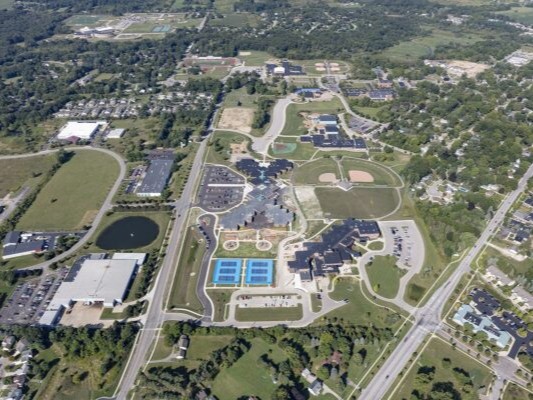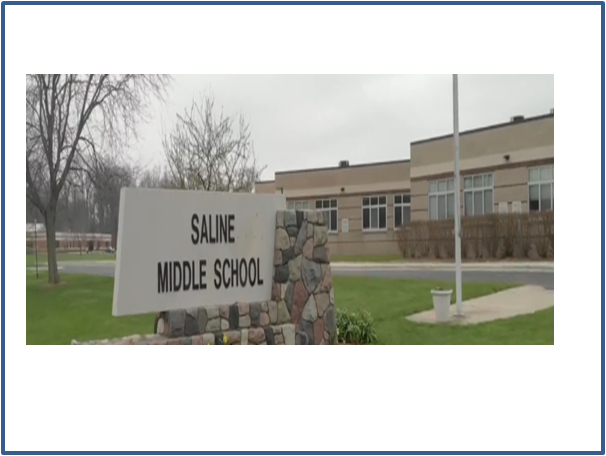As Dexter voters prepare for the May 6th school bond proposal, former school board member Dick Lundy highlights the plan’s role in maintaining, enhancing, and reimagining district facilities without raising taxes.
Photo: Aerial view of Dexter Community Schools campus. Photo courtesy of DCS
By Dick Lundy
EDITOR’S NOTE: Dick Lundy served on the Dexter Community Schools Board of Education for 45 years, playing a key role in overseeing district planning, budgeting, and facility improvements. During his tenure, he was involved in multiple successful bond initiatives, ensuring responsible funding for school infrastructure and educational advancements. His deep knowledge of school operations, combined with decades of community involvement, gives him a unique perspective on the upcoming millage proposal.
The upcoming School Bond Proposal on the May 6th Ballot provides our community with an opportunity to continue to support the maintenance and enhancement of district facilities and resources for the next five to ten years. Possibly of even more significance is the plan to reimagine our educational structure for decades into the future. The elements of the proposal will address continuing care of our existing facilities while enhancing learning spaces with innovation, flexibility, and additional opportunities to provide current and future “Best Practices” in our “Teaching/Learning” spaces and resources. It will provide and enhance our spaces and resources for supporting Art, Music, Athletics, and other Extracurricular activities for both students and residents of all ages in our community.
GOALS
Safety and Security
While much has already been done to ensure the safety and security of students and staff, more enhancements are available as more is learned from current realities. More controlled and effective building access is included for every classroom building.
Infrastructure
Maintain and upgrade the infrastructure of approximately One Million Square feet of Indoor Space and 900,000 Square Feet of Parking Lots plus other Outdoor Space. This includes doors, windows, roofs, HVAC and Boiler equipment, restrooms, lighting, flooring, walls, ceilings, technology, plumbing, sidewalks, and playground equipment. Properly maintaining what we have in a timely fashion prevents major repairs and emergency issues from occurring, and which are far more costly to fix. It is no different than what homeowners are faced with, but on a much, much larger scale.
Planning For Future Teaching/Learning
Creating learning spaces and resources which will provide opportunities for innovation, flexibility, and growth to support new “Best Practices” for excellent student learning. Broad, comprehensive thinking about the future of learning is a cornerstone for providing and supporting the best possible programming to enhance and individualize learning opportunities for every student.
Reimagining our campus to better align students with the most appropriate and effective learning facilities and resources. Specifically creating the Elementary Campus for Young Fives through Sixth Grade and the Secondary Campus for Grades Seven through Twelve.
Student and Community Facilities Beyond the Classroom
Provide improved and additional resources and facilities for all ages in our community. This includes upgrading playground equipment at elementary buildings, addressing gymnasium needs including floors, bleachers, and equipment where needed, addressing mechanical systems in pools and gyms, adding a new expanded weight room to accommodate significant growth in usage, upgrading Al Ritt Stadium, providing new restroom facilities where they don’t exist for athletic fields, building new indoor multi-purpose space to support athletics, recreation, and community activities. Provide for future infrastructure and program upgrades at the new Senior Center and Wellness Center.
Provide Financial Stability for Residents and School System
Provide only items that will continue, but NOT increase cost to taxpayers by continuing the same Debt Service Millage rate that has been in place for the past three decades. Sale of Bonds for project and other bond expenditures will be phased over the next eight to ten years to allow this goal to be met. Projections must be and have been reviewed and approved by the State to verify that everything is accurate and properly controlled.
Provide modern facilities across the campus which result in efficient, cost-effective resources and allow more dollars in the operating budget to be directed to supporting opportunities for students.
RECOMMENDATION PROCESS
The process for developing the final Bond Proposal recommendations was the most thorough, broad-based, and comprehensive that I have ever seen in all of my years with the school district. It involved professionals who have significant background in school construction and programming, including our architects and construction managers; professional engineers whose expertise is Mechanical, Electrical, and Plumbing; Technology Systems; Site, Landscape, and Field Design; our professional staff and support staff who are the current and future users and most knowledgeable about what works well and how to improve and enhance the success of their everyday responsibilities and activities. Very importantly it included a significant number of parents and citizens who helped shape, verify, analyze, evaluate, and assess the need for, and value of, the various possible approaches being considered. Also, Financial Consultants helped create a realistic financial plan for issuing and phasing for the Bond. Countless hours were spent touring facilities, studying alternatives, and prioritizing possible options over the course of the past year and then generating the final list of recommendations which met the financial goals for our taxpayers. The talent, experience, and expertise of the individuals serving on the steering committee not only brought a review of our district’s needs, but also brought tremendous insight into what works well in other school districts and what is being studied for future value.
HISTORICAL CONTEXT
Age of School Buildings
Bates: Built 1953 as a 2-4 School. (Copeland was the K-1 Building) Wylie: Built 1956 as a 5-8 School
Creekside: Built 1958 as a High School Cornerstone: Built 1993 (Now Anchor) Beacon: Built 2017
Mill Creek: Built 1993
High School: Built 1998
These buildings have been added on to and modernized periodically and are well taken care of – no matter how old.
Bond Proposals have been supported by the community in 1987, 1993, 1998, 2008, and 2017. Bonding for the Community Pool was passed in 1989.
All of these Bond Proposals have been implemented on schedule, on budget, and with, not perfect, but still excellent quality. What was promised to our taxpayers and stakeholders has been delivered, meeting our commitment to our students and the community. There has been a proven record of successfully implementing these improvements for our community for decades.
CONCLUSION
The Dexter Community School District has been blessed for decades and is now one of the premier districts in the state. Other districts come to Dexter to study our successes. Our achievements are many including Academic excellence, Athletic successes, and student achievements after graduation. Real Estate agents state unequivocally that the growth of the larger Dexter community is primarily the result of the reputation of our schools. This is the result of the superb leadership in the school district, the excellence and caring of our professional staff and support staff, and probably most important the support of parents and community members who have so unselfishly supported our schools in so many ways, including the financial support for our facilities and resources.
I believe that while the City of Dexter is the focal point of our community, it is the school system that primarily defines our larger community. As a community consisting of parts of eight townships in two counties, plus the City, the district is the only entity with the capacity and resources to provide for not only the educational services for our students (our primary mission), but also to provide services for babies, art, music, recreational opportunities, community education for all ages, support for our senior (older) citizens, and the new Multigenerational Community Center.
This is a well-thought-out proposal to set in place the foundation for the future success of our schools and our community.
The Dexter Community Schools accept this responsibility and are pleased to play such a significant and important service, and I respectfully encourage our residents and taxpayer stakeholders to continue the fantastic support given in the past by supporting this Bond Proposal.






 8123 Main St Suite 200 Dexter, MI 48130
8123 Main St Suite 200 Dexter, MI 48130


